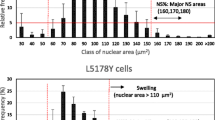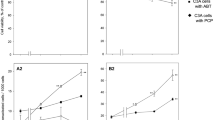Abstract
In order to investigate the chromosomal genotoxicity of nitrobenzene and benzonitrile, we studied the induction of micronuclei (MN) by these test compounds in V79 cells, as well as effects on the formation and stability of microtubules and on motor protein functions. No cytotoxicity was seen in V79 cell cultures in terms of Neutral red uptake after 18 h treatment with up to 1 mM nitrobenzene or 1 mM benzonitrile. Subsequently, a concentration range up to 100 µM was used in the experiments on induction of MN. Both test compounds exhibit a weak, but definitely positive test result compared to the solvent (DMSO) control. Minimal effect concentrations of nitrobenzene and benzonitrile appeared as low as 0.01 µM, and no-effect-concentrations were between 0.001 and 0.005 µM. Clearly enhanced MN rates were found at 0.1 µM and higher. Both, nitrobenzene and benzonitrile, induced mostly kinetochor (CREST)-positive micronuclei, thus characterising the chromosomal effects as aneugenic. In cell-free assays, a slight effect on tubulin assembly was observed at 1 mM nitrobenzene without addition of DMSO. Higher concentrations (5 mM) led to secondary effects. In presence of 1% DMSO, nitrobenzene exerted no detectable effect on tubulin assembly up to the solubility limit in water of about 15 mM. For benzonitrile in presence of DMSO, a clear dose–response of inhibition of tubulin assembly at 37°C was seen above the no-effect-concentration of 2 mM, with an IC50 of 13 mM and protein denaturation starting above a level of about 20 mM. The nature of the effects of nitrobenzene and benzonitrile on the association of tubulin to form microtubules was confirmed by electron microscopy. Treatment by either 5 mM nitrobenzene or 13 mM benzonitrile plus 1% DMSO left the microtubular structure intact whereas 5 mM nitrobenzene, in absence of DMSO, led to irregular cluster formations. The experiments demonstrate that both nitrobenzene and benzonitrile, in millimolar concentration ranges, may lead to interference with tubulin assembly in a cell-free system. The functionality of the tubulin–kinesin motor protein system was assessed using the microtubule gliding assay. Nitrobenzene affected the gliding velocity in a concentration-dependent manner, starting at about 7.5 µM and reaching complete inhibition of motility at 30 µM, whereas benzonitrile up to 200 µM did not affect the kinesin-driven gliding velocity. The micronucleus assay data demonstrate a chromosomal endpoint of genotoxicity of nitrobenzene and benzonitrile. Aneugenic effects of both compounds occur at remarkably low concentrations, with lowest-effect-concentrations being 0.1 µM. This points to the relevance of interactions with the cellular spindle apparatus.







Similar content being viewed by others
References
Albertini S, Zimmermann FK (1991) The detection of chemically induced chromosomal malsegregation in Saccharomyces cerevisiae D61.M: a literature survey (1984–1990). Mutat Res 258:237–258
Albrecht W, Neumann HG (1985) Biomonitoring of aniline and nitrobenzene. Hemoglobin binding in rats and analysis of adducts. Arch Toxicol 57:1–5
Böhm KJ, Stracke R, Unger E (2000) Speeding up kinesin-driven microtubule gliding in vitro by variation of cofactor composition and physicochemical parameters. Cell Biol Int 24:335–341
Bolt HM (2003) Genotoxicity––threshold or not? Introduction of cases of industrial chemicals. Toxicol Lett 140/141:43–51
Borenfreund E, Babich H, Martin-Alguacil N (1988) Comparisons of two in vitro cytotoxicity assays—the neutral red (NR) and tetrazolium MTT test. Toxicol In Vitro 2:1–6
Cattley RC, Everitt JI, Gross GA, Moss OR, Hamm TE Jr, Popp JA (1994) Carcinogenicity and toxicity of inhaled nitrobenzene in B6C3F1 mice and F344 and CD rats. Fundam Appl Toxicol 22:328–340 [Erratum in 25:159, 1005]
Countryman PI, Heddle JA (1976) The production of micronuclei from chromosome aberrations in irradiated cultures of human lymphocytes. Mutat Res 41:321–332
Crebrelli R (2000) Threshold-mediated mechanisms in mutagenesis: implications in the classification and regulation of chemical mutagens. Mutat Res 464:129–135
Decordier I, Dillen L, Cundari E, Kirsch-Volders M (2002) Elimination of micronucleated cells by apoptosis after treatment with inhibitors of microtubules. Mutagenesis 17:337–344
Fenech M (1993) The cytokinesis-block micronucleus technique: A detailed description of the method and its application to genotoxicity studies in human populations. Mutat Res. 285:35–44
Gaskin F, Cantor CR, Shelanski ML (1974) Turbidimetric studies of the in vitro assembly and disassembly of porcine neurotubules, J Mol Biol 89:737–755
Hartwig A, Schwerdtle T (2002) Interactions by carcinogenic metal compounds with DNA repair processes: toxicological implications. Toxicol Lett 12:47–54
Hengstler JG, Bogdanffy MS, Bolt HM, Oesch F (2003) Challenging dogma: thresholds for genotoxic carcinogens? The case of vinyl acetate. Annu Rev Pharmacol Toxicol 43:485–520
Holder JW (1999a) Nitrobenzene carcinogenicity in animals and human hazard evaluation. Toxicol Ind Health 15:445–457
Holder JW (1999b) Nitrobenzene potential human cancer risk based on animal studies. Toxicol Ind Health 15:458–463
IARC (International Agency for Research on Cancer) (1996) Nitrobenzene. In: IARC Monographs on the evaluatiuon of carcinogenic risks to humans, vol. 65. IARC Press, Lyon, pp 380–408
Kiese M (1974) Methemoglobinemia: a comprehensive treatise. CRC Press, Cleveland
Kirsch-Volders M, Aardema M, Elhajouji A (2000) Concepts of threshold in mutagenesis and carcinogenesis. Mutat Res 464:3–11
Kirsch-Volders M, Vanhauwaert A, Eichenlaub-Ritter U, Decordier I (2003) Indirect mechanisms of genotoxicity. Toxicol Lett 140/141:63–74
Lewalter J, Korallus U (1985) Blood protein conjugates and acetylation of aromatic amines. New findings on biological monitoring. Int Arch Occup Environ Health 56:179–196
Li H, Wang H, Sun H, Liu Y, Liu K, Peng S (2003) Binding of nitrobenzene to hepatic DNA and hemoglobin at low doses in mice. Toxicol Lett 139:25–32
Madle S, von der Hude W, Broschinski L, Jänig GR (2000) Threshold effects in genetic toxicity: perspective of chemicals regulation in Germany. Mutat Res 464:117–121
Matsuoka A, Yamazaki N, Suzuki T, Hayashi M, Sofuni T (1992) Evaluation of the micronucleus test using a Chinese hamster cell line as an alternative to the conventional in vitro chromosomal aberration test. Mutat Res 272:223–236
Miller BM, Adler ID (1990) Application of antikinetochore antibody staining (CREST staining) to micronuclei in erythrocytes induced in vivo. Mutagenesis 5:411–415
Niclas J, Navone F, Hom-Booher N, Vale RD (1994) Cloning and localization of a conventional kinesin motor expressed exclusively in neurons. Neuron 12:1059–1072
Osgood CJ, Cyr K (1998) Induction by nitriles of sex chromosome aneuploidy: tests of mechanism. Mutat Res 403:149–157
Parry JM (2000) Reflections on the implications of thresholds of mutagenic activity for the labelling of chemicals by the European Union. Mutat Res 464:155–158
Parry JM, Jenkins GJS, Haddad F, Bourner R, Parry EM (2000) In vitro and in vivo genotoxin exposures: consideration of factors which influence dose–response thresholds. Mutat Res 464:53–63
Pratt IS, Barron T (2003) Regulatory recognition of indirect genotoxicity mechanisms in the European Union. Toxicol Lett 140/141:53–62
Purchase HF, Barrett JC, Pitot HC, Yamasaki H (eds) (1995) Receptor mediated mechanisms in chemical carcinogenesis. Special issue. Mutat Res 333:1–224
Renzi L, Pacchierotti F, Russo A (1996) The centromere as a target for the induction of chromosome damage in resting and proliferating mammalian cells: assessment of mitomycin C-induced genetic damage at kinetochores and centromeres by a micronucleus test in mouse splenocytes. Mutagenesis 11:133–138
Russo A, Stocco A, Majone F (1992) Identification of kinetochore-containing (CREST+) micronuclei in mouse bone marrow erythrocytes. Mutagenesis 7:195–197
Sarrif AM, Aardema MJ, Albertini S, Arni P, Henderson LM, Kirsch-Volders M, Vrijhof H (2000) General introduction. ECETOC–EEMS symposium on dose–response and threshold-mediated mechanisms in mutagenesis (Salzburg, Austria; 7 September 1998). Mutat Res 464:1–2
Schuler M, Rupa DS, Eastmond DA (1997) A critical evaluation of centromeric labeling to distinguish micronuclei induced by chromosomal loss and breakage in vitro. Mutat Res 392:81–95
Schultz N, Önfelt A (2000) Sensitivity of cytokinesis to hydrophobic interactions. Chemical induction of bi- and multinucleated cellos. Chem Biol Interac 126:97–123
SCOEL (2002) Recommendation from Scientific Committee on Occupational Exposure Limits for nitrobenzene. Luxemburg, March 2002
Seeley MR, Tonner-Navarro LE, Beck BD, Deskin R, Feron VJ, Johanson G, Bolt HM (2001) Procedures for health risk assessment in Europe. Regul Toxicol Pharmacol 34:153–169
Seiler JP (1977) Apparent and real threshold: a study on two mutagens. In: Scott D, Bridges BA, Sobels FH (eds) Progress in genetic toxicology. Elsevier/North Holland Biomedical Press, Amsterdam, pp 233–238
Shelanski ML, Gaskin F, Cantor CR (1973) Microtubule assembly in the absence of added nucleotides. Proc Natl Acad Sci USA 70:765–768
Speit G, Autrup H, Crebelli R, Henderson L, Kirsch-Volders M, Madle S, Parry JM, Sarrif AM, Vrijhof H (2000) Thresholds in genetic toxicology—concluding remarks. Mutat Res 464:149–153
Thier R, Lewalter J, Selinski S, Bolt HM (2001) Biological monitoring in workers in a nitrobenzene reduction plant: haemoglobin versus serum albumin adducts. Int Arch Occup Environ Health 74:483–488
Thier R, Bonacker D, Stoiber T, Böhm KJ, Wang M, Unger E, Bolt HM, Degen G (2003) Interaction of metal salts with cytoskeletal motor protein systems Toxicol Lett 140/141:75–81
Unger E, Böhm KJ, Müller H, Grossmann H, Fenske H, Vater W (1988) Formation of double-walled microtubules and multilayered tubulin sheets by basic proteins. Eur J Cell Biol 46:98–104
Weingarten MD, Lockwood AH, Hwo SY, Kirschner MW (1975) A protein factor essential for microtubule assembly. Proc Natl Acad Sci USA 72:1858–1862
Weiss DG, Maile W (1992) Principles, practice and applications of video-enhanced contrast microscopy. In: Shotton DM (ed) Electronic light microscopy. Wiley-Liss, New York, pp 105–140
Acknowledgements
The authors are indebted to the Long Range Research Programme of the European Chemical Industry (CEFIC/LRI: grant no. CC-1FFOAR-0003) and thank it for this financial support. They also thank Dr. Awni M. Sarrif for his continuous stewardship of the project. Thanks are also due to Dr. Rone D. Vale, Howard Hughes Medical Institute, University of California, San Francisco, CA, USA, for kindly providing the cDNA plasmid pWBC7.
Author information
Authors and Affiliations
Corresponding author
Rights and permissions
About this article
Cite this article
Bonacker, D., Stoiber, T., Böhm, K.J. et al. Chromosomal genotoxicity of nitrobenzene and benzonitrile. Arch Toxicol 78, 49–57 (2004). https://doi.org/10.1007/s00204-003-0508-1
Received:
Accepted:
Published:
Issue Date:
DOI: https://doi.org/10.1007/s00204-003-0508-1




